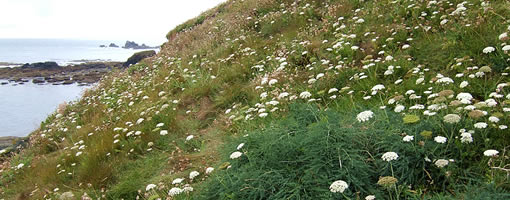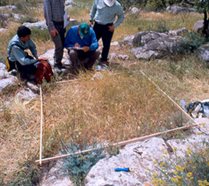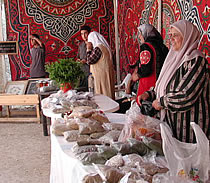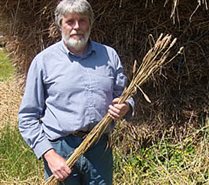
Wild carrot and asparagus growing on the Lizard Peninsula Cornwall

Lead academic: Professor Nigel Maxted
Introduction
Dr Nigel Maxted's work on genetic conservation of crop wild relatives and landraces (traditional farmer-bred crop varieties) is providing a template for the conservation of agrobiodiversity and other plant species in the UK, Europe and many countries around the globe.
Research objectives - what was the challenge?
Ensuring Food Security in the face of climate change is one of the major challenges that confronts humankind in the 21st century. It is now widely recognized that the remaining genetic diversity found in the wild species related to domesticated crops is an important reservoir of genes that are required to develop new varieties suited to meet the dual challenges of climate change while feeding a rising human population.

Conservation trainees in Palestine learning to monitor plant populations
Crop wild relatives (CWR) are being increasingly mined for and providing novel resistance to pests and diseases, and drought and soil salinity. While traditional crop landraces (LR), often disregarded as inferior to modern cultivars, are now recognized for their role sustaining production in marginal environments and meeting the needs of niche markets. Both CWR and LR diversity is threatened by mismanagement of the environment and unsustainable changes in agricultural practices, thus CWR and LR conservation are directly linked to human future well-being. The conservation of agrobiodiversity has historically been largely ad hoc and thus not fit for purpose in underpinning current and future farmers’ and consumers’ demands.
Research outputs - what was the process?
Work over the past 20 years by the Birmingham Plant Genetic Resource Group (PGR) led by Professor Nigel Maxted has had a substantial impact supplying the scientific foundation for robust conservation strategies and associated policies resulting in enhanced sustainable exploitation globally.
Research by the PGR group has developed strategies that provide a systematic framework to conservation by extending ‘gap analysis’, an ecosystem conservation methodology, to agrobiodiversity.
This involves:
- identifying target organisms and target areas;
- assessing the natural diversity and the threat to this diversity;
- reviewing current conservation strategies;
- and reformulating the conservation strategy by finding the ‘gaps’ between natural, intrinsic diversity and that diversity already effectively conserved in situ (within the target area) and ex situ (where, as a last resort, organisms may be conserved off-site, ie; in another conservation area or a gene bank).
Through their work the group have defined the minimum requirements for conservation and utilisation of CWR / LR, identifying global conservation priorities in relation to fulfilling the requirement for Food Security. Coupled with this the PGR group have pioneered approaches for generating CWR and LR conservation inventories that are readily accessible to stakeholders using web-enabled databases. The group have demonstrated how the use of genetic markers and new technologies, such as transcriptomics, can be integrated into agrobiodiversity programmes, for instance through the identification of adaptive genes that can contribute to the mitigation of climate change.
Transcriptomics
The genome is made up of DNA, a long, winding molecule that contains the instructions needed to build and maintain cells. For these instructions to be carried out, DNA must be transcribed into corresponding molecules of RNA, referred to as transcripts. A transcriptome is a collection of all the transcripts present in a given cell. Transcriptomics is the study of how the whole transcriptome changes in response to a range of biological conditions.
Research impact
National agencies are obliged under treaty commitments to promote agrobiodiversity conservation as a basis for sustaining food security. This requires more effective strategies for both in situ and ex situ plant conservation. Research based on the expertise of Professor Maxted in conservation, genomics and policy is providing the foundation for regulatory agencies to improve genetic diversity maintenance, enhance its use and so sustain food security. For example, the UN Food and Agriculture Organisation’s 2013 decision to establish a global network of crop wild relative in situ conservation sites and the UK government’s decision to establish a national LR inventory were based on evidence generated by the research group.

Farmers selling traditional landraces in Jordan
Professor Maxted’s role as Chair of the Defra Plant Genetic Resources Group, together with his Chairing of European and global committees for the Species Survival Commission and Biodiversity International, has resulted in the implementation of agrobiodiversity policy and conservation in the UK, Europe, Africa, Far East and South America. An important recent outcome is the establishment of the first global priority inventory of crop wild relative species based on their value as trait donors for breeding and climate change mitigation, it is now being used international to plan in situ and ex situ conservation action and guide sustainable exploitation by plant breeders.

Wheat landrace maintainer in
Suffolk, UK
Learn More